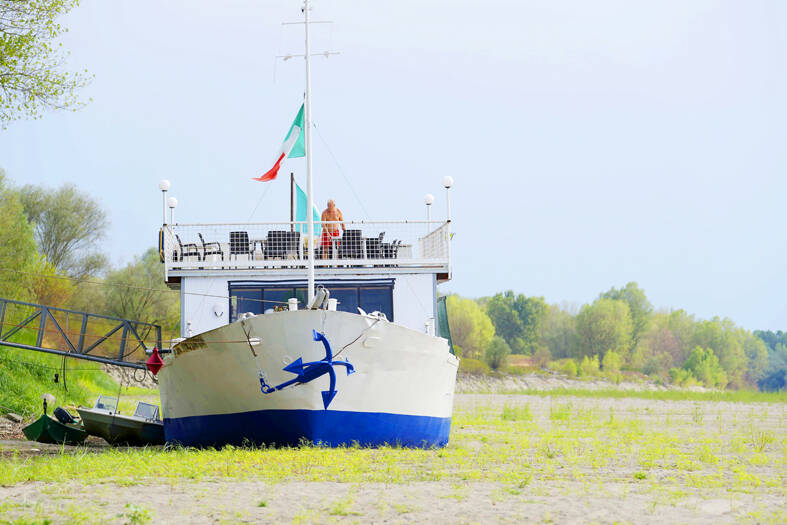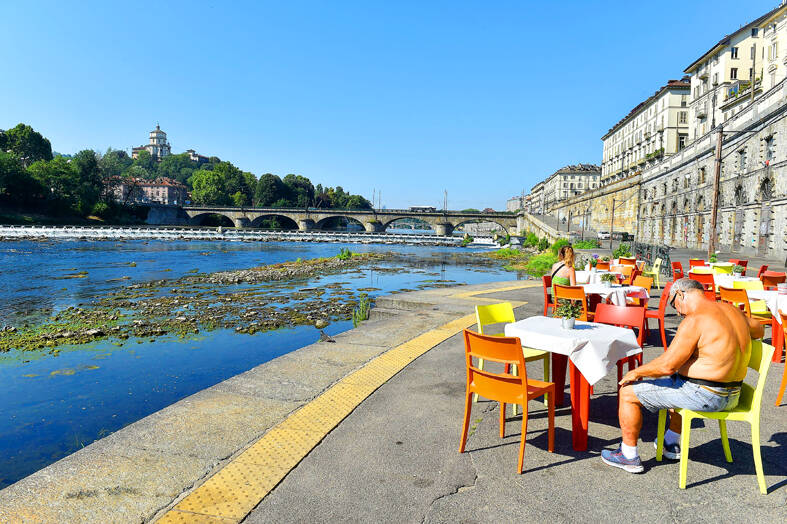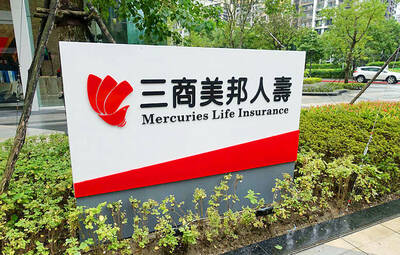There is only a feeble trickle in the irrigation canal feeding farmer Alessandro Salmoiraghi’s field of kiwi fruit in northern Italy.
“The constant problem is the lack of water,” he said. “Even if you diversify, when there is no water, there is simply no water, there is no life, no production.”
Salmoiraghi, 49, is the fourth generation of his family to farm Cascina San Donato, a 24-hectare plot of mainly grain, vegetables and fruit — primarily kiwi — on a normally lush plain just an hour’s drive west of Milan.

Photo: AP
“We used to have higher volumes of water. Now it is just a trickle. If another farmer starts irrigating tomorrow, the flow could easily stop,” Salmoiraghi said at his farm, which also boasts a shop selling fruit, vegetables and preserves.
Across large parts of Europe, climate change is fueling more extreme weather, including longer, harsher droughts and heatwaves that can spur crop failures.
That presents a threat to farmers such as Salmoiraghi and the millions who depend on Europe’s agriculture for food and a living. It is also forcing Italy’s government to take new steps to manage water disputes and renovate infrastructure.

Photo: Reuters
“The climate has changed in the last 10 years,” Salmoiraghi said, pointing to the lack of hard winters and frosty mornings.
Set in a normally lush plain, his farm is fed by the waters of Swiss Alpine glaciers that melt into the Ticino, one of the biggest tributaries of the Po, Italy’s longest river.
After poor winter rains and dismal Alpine snowfalls across northern Italy failed to replenish reserves, the arrival of spring has brought worries of more suffering following last year’s drought, the worst in 70 years.
The vast valley along the banks of the Po, stretching about 650km from the southern Alps and Italy’s northwestern border with France to the shores of the Adriatic Sea in the east, accounts for about one-third of Italy’s agricultural production.
Last year, people could walk across the river bed in places. A boat sunk in World War II stood high and dry in the mud and gauges showed water levels below what normally counts as zero.
Italy is far from alone. Agricultural production is also under strain in France and Spain and the UN Food and Agriculture Organization says that 3.2 billion people worldwide live in areas facing high to very high water scarcity.
Attilio Fontana, president of the Lombardy region, centered on Milan, last month said that regional water storage levels were less than half what they normally are at this time of year.
Coldiretti, Italy’s main farmer’s association, said the sector had lost about 6 billion euros (US$6.6 billion) last year and predicted 300,000 businesses would lose more if the drought does not end.
Experts say that would require almost nonstop rain from now until next month and June, when most farmers start irrigating their fields.
“If no rainfall comes in late spring, we will enter into emergency management, like we did last year, postponing the irrigation season,” said Massimo Sertori, the Lombardy councilor responsible for water resources.
Italy grows about 50 percent of the rice produced in the EU, but is set to cut output this year as farmers plant less because of the drought, Coldiretti said.
About 94 percent of Italy’s crop is grown in Lombardy and in Piedmont, around Turin.
Other crops are also at risk.
“We are especially worried about the spring crops and then vegetables and fruit,” said Lorenzo Bazzana, an economist at Coldiretti.
“At this time of the year, farmers begin sowing maize, soy, sunflower, rice and planting tomato and potatoes. All of these face higher risks,” he said.
If farmers scale back cultivation, it could hurt the whole agricultural supply chain. Corn, for example, is an important fodder for pigs and cows, which supply the ham and cheese products for which Italy is world famous.
Italy exported 61 billion euros of food and agricultural products last year, accounting for 15 percent of its GDP.
Salmoiraghi lost about 30 percent of his corn harvest last year and fears water scarcity will soon become the new normal.
The latest report from the Intergovernmental Panel on Climate Change predicts that rainfall in the Po Valley would vary more in the coming years, with an increase in extreme weather events.
Extreme drought is already affecting 6 percent of towns in Lombardy and Piedmont, with 19 of them experiencing the highest level of shortage, said Utilitalia, a federation of utility companies.
It said that some towns had already started receiving water in tanker trucks.
“The situation remains utterly critical,” said Alessandro Bratti, general secretary of the authority overseeing the River Po basin.
Last year, water from large lakes helped ease the drought’s effects, but water in Lake Garda, which eventually flows into the River Po, is below half of normal levels, the Po River District Basin Authority said.
Italian Prime Minister Giorgia Meloni last month set up a control room to monitor water capacity across the country and is to appoint a national commissioner to oversee the issue.
The commissioner would be able to intervene in issues of water management and mediate between state bodies. Last week, the Cabinet approved a raft of short-term measures to simplify procedures and speed up water infrastructure works. Those who draw water illegally can now face fines of up to 50,000 euros.
Inadequate water storage is a big problem. A new study by the Energy and Water Foundation and Proger KSA said that Italy receives an average annual rainfall of 301 billion cubic meters, but collects and redistributes only 11 percent of it.
The study also found that the country’s 531 major dams are operating far below capacity due to technical issues and lack of investment.
At the local level, the Lombardy government has asked water companies and hydroelectric operators to limit their usage.
“We are seeking a point of equilibrium that allows us to fill the lakes, without hampering energy production,” Sertori said.
Sertori said that in the long run, he believes lakes will be key to boosting water storage, with the region undertaking renovation work to expand capacity.
While waiting to see what effect the measures have, farmers are looking for their own ways to adapt.
Salmoiraghi last year bought a new, more efficient irrigation system, but he was also helped by the rise in commodity prices offsetting the loss in productivity.
This year, he has already sown more crops, including soy, that require less water.
For now, he is just thinking about reducing the possible harm. “You opt for the easy crops. If it turns bad, at least I lose only one harvest and not the whole season.”

Mercuries Life Insurance Co (三商美邦人壽) shares surged to a seven-month high this week after local media reported that E.Sun Financial Holding Co (玉山金控) had outbid CTBC Financial Holding Co (中信金控) in the financially strained insurer’s ongoing sale process. Shares of the mid-sized life insurer climbed 5.8 percent this week to NT$6.72, extending a nearly 18 percent rally over the past month, as investors bet on the likelihood of an impending takeover. The final round of bidding closed on Thursday, marking a critical step in the 32-year-old insurer’s search for a buyer after years of struggling to meet capital adequacy requirements. Local media reports

US sports leagues rushed to get in on the multi-billion US dollar bonanza of legalized betting, but the arrest of an National Basketball Association (NBA) coach and player in two sprawling US federal investigations show the potential cost of partnering with the gambling industry. Portland Trail Blazers coach Chauncey Billups, a former Detroit Pistons star and an NBA Hall of Famer, was arrested for his alleged role in rigged illegal poker games that prosecutors say were tied to Mafia crime families. Miami Heat guard Terry Rozier was charged with manipulating his play for the benefit of bettors and former NBA player and

TECHNOLOGICAL RIVALRY: The artificial intelligence chip competition among multiple players would likely intensify over the next two years, a Quanta official said Quanta Computer Inc (廣達), which makes servers and laptops on a contract basis, yesterday said its shipments of artificial intelligence (AI) servers powered by Nvidia Corp’s GB300 chips have increased steadily since last month, should surpass those of the GB200 models this quarter. The production of GB300 servers has gone much more smoothly than that of the GB200, with shipments projected to increase sharply next month, Quanta executive vice president Mike Yang (楊麒令) said on the sidelines of a technology forum in Taipei. While orders for GB200 servers gradually decrease, the production transition between the two server models has been

BETTER THAN EXPECTED: The firm’s Q3 results exceeded its projections, based on ‘the underlying strength of our core markets,’ chief financial officer Dave Zinsner said Intel Corp returned to profitability and gave an upbeat revenue forecast after PC demand grew, suggesting that it is making progress on a long and challenging comeback attempt. In the third quarter, revenue rose 3 percent to US$13.7 billion. The Santa Clara, California-based company posted its first quarterly net income since the end of 2023, with earnings per share of US$0.23, excluding some items. Analysts had estimated sales of US$13.2 billion and earnings per share of US$0.01 on average, according to data compiled by Bloomberg. Fourth-quarter sales would be roughly US$13.3 billion, the company said in a statement on Thursday. Intel shares gained about